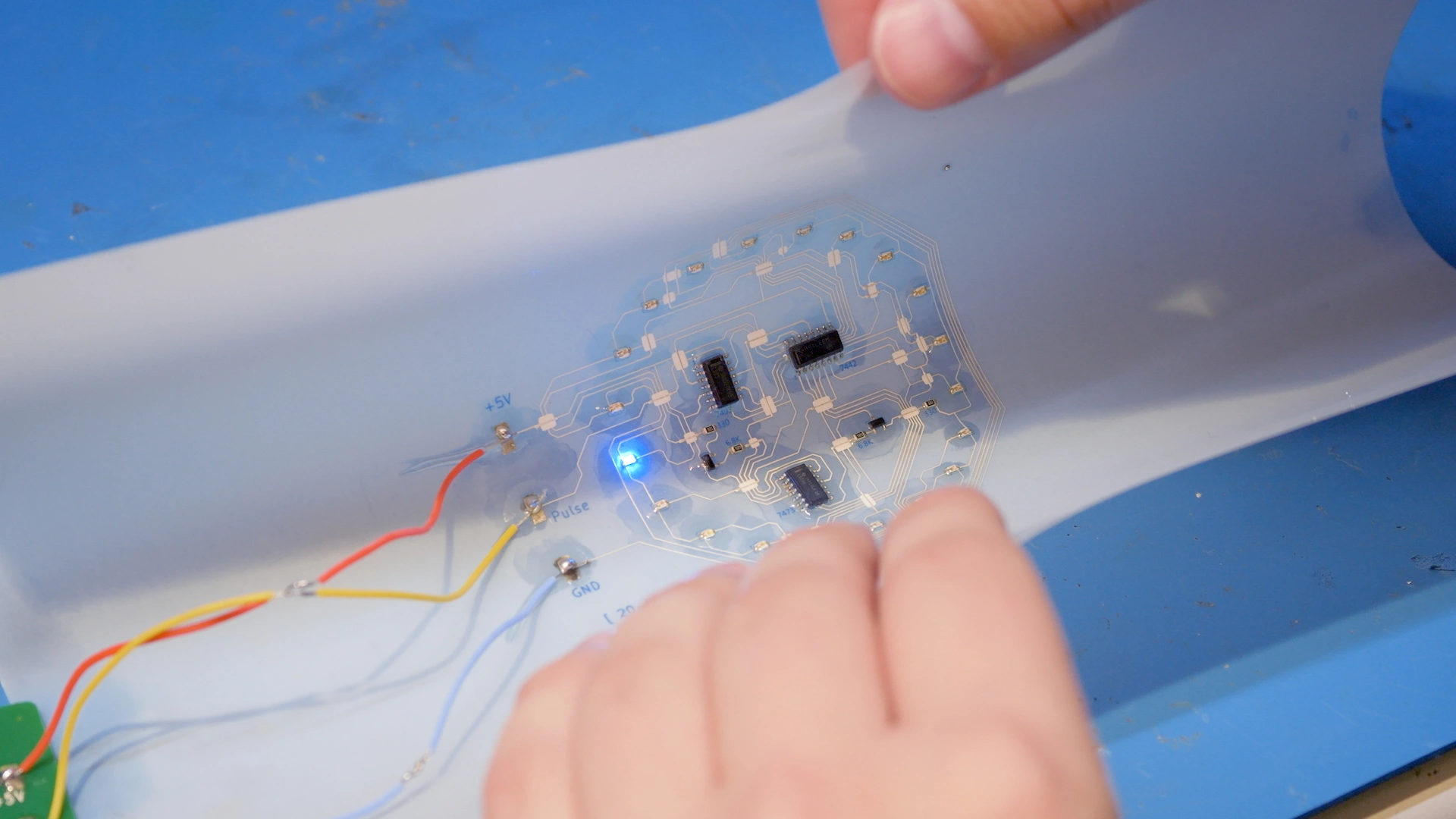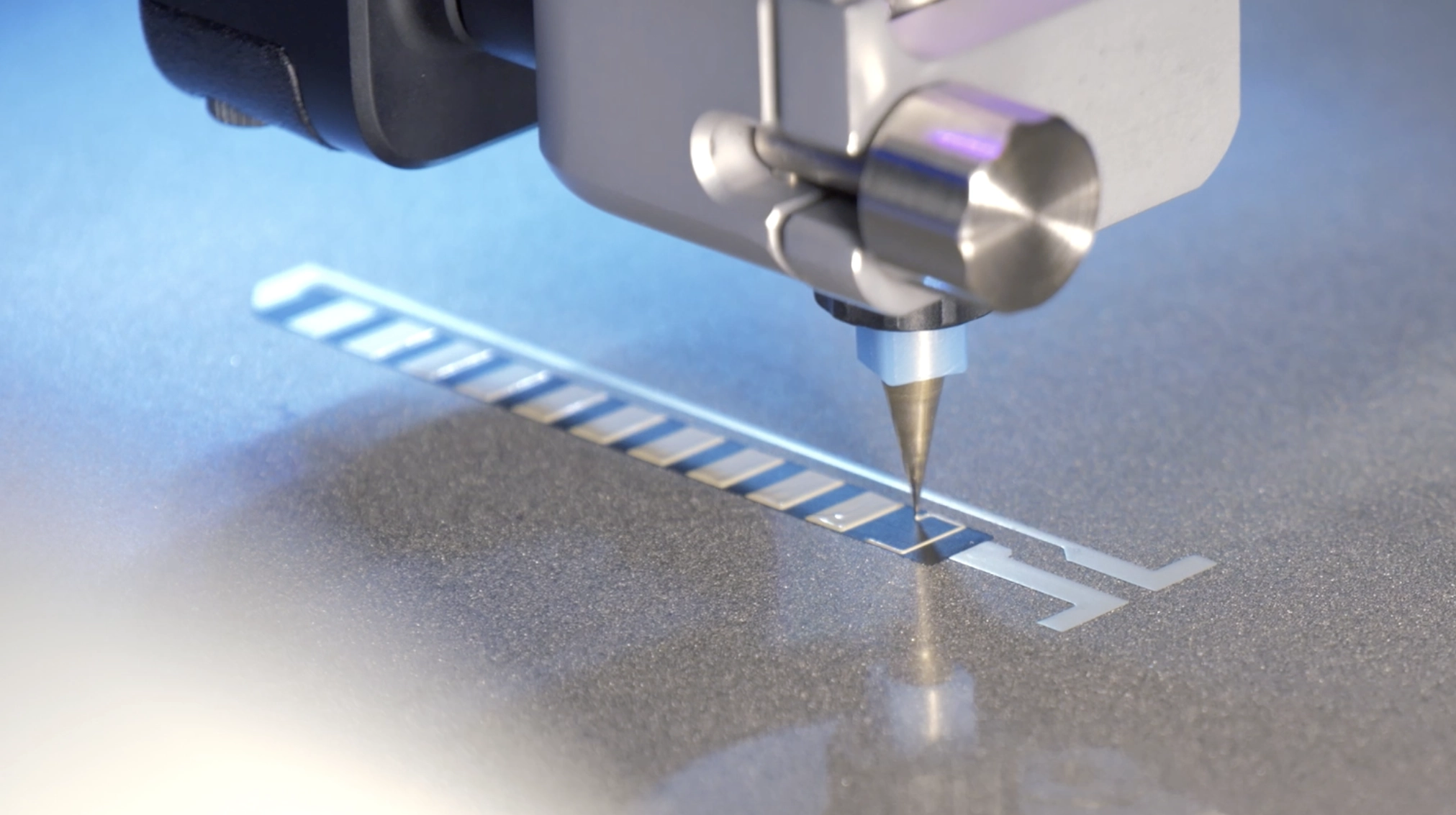White paper
Printing ECG Electrodes with Biocompatible Gold Ink on TPU
Electrocardiogram (ECG) electrodes are sensors attached to the skin that detect the electrical activity of the heart. They are critical components of ECG systems used for diagnosis and management of cardiovascular diseases. This project demonstrates the process of printing a set of dry ECG electrodes.


- Creative Materials EXP 2613-40 gold ink
- Celanese Micromax™ Intexar™ PE874 stretchable silver paste
- Voltera Conductor 3 silver ink
Project Overview
Purpose
The purpose of this project was to demonstrate how we validated the effectiveness of printing ECG electrodes on TPU using biocompatible gold ink and stretchable silver ink. We used the Voltera NOVA materials dispensing system and the Voltera V-One PCB printer for this purpose.
Design
We divided the project into three main parts:
- The ECG electrodes to be attached to the skin
- The control unit with the heart rate monitor and the controller
- An enclosure that protects the control unit from impact
The SparkFun Heart Rate Monitor AD8232 (SENS-12650) acts as a pre-amplifier, transforming the heart’s biopotentials picked up by the ECG electrodes into a usable voltage while also rejecting electrical noise inherent in the measurement. The Arduino Micro captures the voltage and interprets it as a graph of the heart waveform through a program that we custom-made for this project.


Desired outcome
The printed electrodes should be flexible enough to conform to body movement and different physiques. Once the gold ECG electrodes are attached to the skin and connected to the circuit, we connect the circuit to power. The Arduino Micro controller should accurately interpret heart rates and rhythm readings.
Functionality
Inspired by this study where researchers developed a hexagonal labyrinth pattern as an optimized dry electrode geometry, this design allowed for maximum sensitivity while eliminating the need for wet gel, which can cause skin irritation in some patients.
For this project we printed a set of three electrodes, to be placed on the chest, as a proof of concept. Although this design was able to output data into meaningful graphs, commercial ECGs typically have 12 points of readings. As such, this project is not intended for diagnosis or treatment of any medical conditions.
Printing and post-processing the ECG electrodes
To ensure the electrodes could conform to body movement and accommodate different physiques, we designed the corners to be stretchable. We divided the layout into two layers:
- Base silver layer for stretchability
- Top gold layer for biocompatibility


This approach allowed us to use a relatively small amount of gold ink to minimize costs while achieving the desired outcome.
Printing the base silver layer
This layer consists of three circle patterns designed to connect to metal snaps, as well as traces that connect to the gold layer. For ease of alignment, we also included four sets of fiducials at each corner of the individual patterns.


| Ink | Celanese Intexar PE874 |
| Substrate | TPU |
| Nozzle Type | Nordson EFD 7018424 dispensing tip, 150 µm inner diameter |
| Probe Pitch | 5 mm |
| Cure Time and Temperature | 15 minutes at 130°C |


Printing the top gold layer
This layer consists of three hexagonal labyrinth patterns with traces that connect to the silver layer.
Similar to the silver layer, we included four sets of fiducials for better alignment and precise cutting of the substrate.


| Ink | Creative Materials EXP 2613-40 gold ink |
| Substrate | TPU |
| Nozzle Type | Nordson EFD 7018395 dispensing tip, 200 µm inner diameter |
| Probe Pitch | 5 mm |
| Cure Time and Temperature | 10 minutes at 135°C |




Post-processing of the electrodes
After the electrodes were printed, we punched a hole in the middle of the silver circle on each electrode for the metal snaps. Next, we folded the electrodes in the middle and inserted the metal snaps into the punched holes.


We cut three PET sheets proportional to the labyrinth pattern with the intention of inserting them between the layers of TPU. This added strength to the electrodes, preventing excessive stretching that could cause the gold ink to lose conductivity. We laminated them together using a T-shirt press machine. The electrodes were now ready to be connected to the heart rate monitor via the sensor cable.


Printing the control unit
To mount the Arduino Micro controller and the SparkFun Heart Rate Monitor, we needed to drill a few holes on an FR1 board using V-One. After drilling, we used V-One to print silver traces that electrically connected the two components together.




We then inserted rivets, mounted the components in place, and connected the wires from the heart rate monitor to the electrodes.


Printing the enclosure
To protect the control unit from impact, we designed and 3D printed an enclosure that consists of a top and a bottom cover.




After placing the control unit inside, we bolted the top and bottom covers together.


Challenges and advice
Minimizing material waste
One of the primary challenges we encountered was managing the gold ink. Given its high cost, we aimed to avoid waste. To mitigate this risk, we initially experimented with alternative inks to validate the electrode design. We tested silver ink first to ensure successful prints before proceeding with the gold ink. We also included overlapping fiducial marks for the two layers in our design to ensure precise alignment.
Optimizing ink flow
The gold particles settled at the bottom due to being left unused for extended periods, which initially resulted in the nozzle clogging. We resolved this issue by mixing the gold ink using a dual asymmetric centrifugal mixer before printing.
Conclusion
While working with gold ink presented new challenges, using NOVA allowed us to precisely control the amount of ink dispensed, a benefit particularly relevant for applications using expensive materials.
If you are interested to learn more, Voltera’s co-founder and Director of Revenue, Katarina Ilić, gave a keynote on this project at TechBlick’s Printed Electronics Innovation Day, December 11, 2024. Watch the video:
Frequently asked questions
What are printed ECG electrodes and how do they work?
Printed ECG electrodes are skin-contact electrodes fabricated by printing conductive and biocompatible inks onto flexible substrates such as TPU. When placed on the skin, they pick up the heart’s electrical signals, which are then amplified and processed by a heart rate monitor circuit. In this project, stretchable silver ink provides mechanical compliance, while a thin gold layer ensures stable, skin-safe electrical contact.
How do printed ECG electrodes differ from traditional gel electrodes?
Traditional ECG electrodes rely on adhesive pads and conductive gel to reduce skin–electrode impedance. Printed ECG electrodes are dry electrodes, meaning they do not require gel. This reduces skin irritation, simplifies application, and enables longer-term or wearable use. While gel electrodes often provide lower initial contact resistance, printed dry electrodes offer improved comfort, flexibility, and reusability, especially in wearable or textile-integrated systems.
What materials are used for printed ECG electrodes?
Printed ECG electrodes typically use a combination of stretchable conductive inks, such as silver, and biocompatible materials like gold for the skin-contact layer. Flexible substrates such as TPU allow the electrodes to conform to body movement. Additional layers or laminates may be added to reinforce mechanical strength and maintain conductivity during repeated bending or stretching.

Printing multilayer flexible, stretchable, and conformable electronics?
NOVA’s Plan feature makes it easy.
